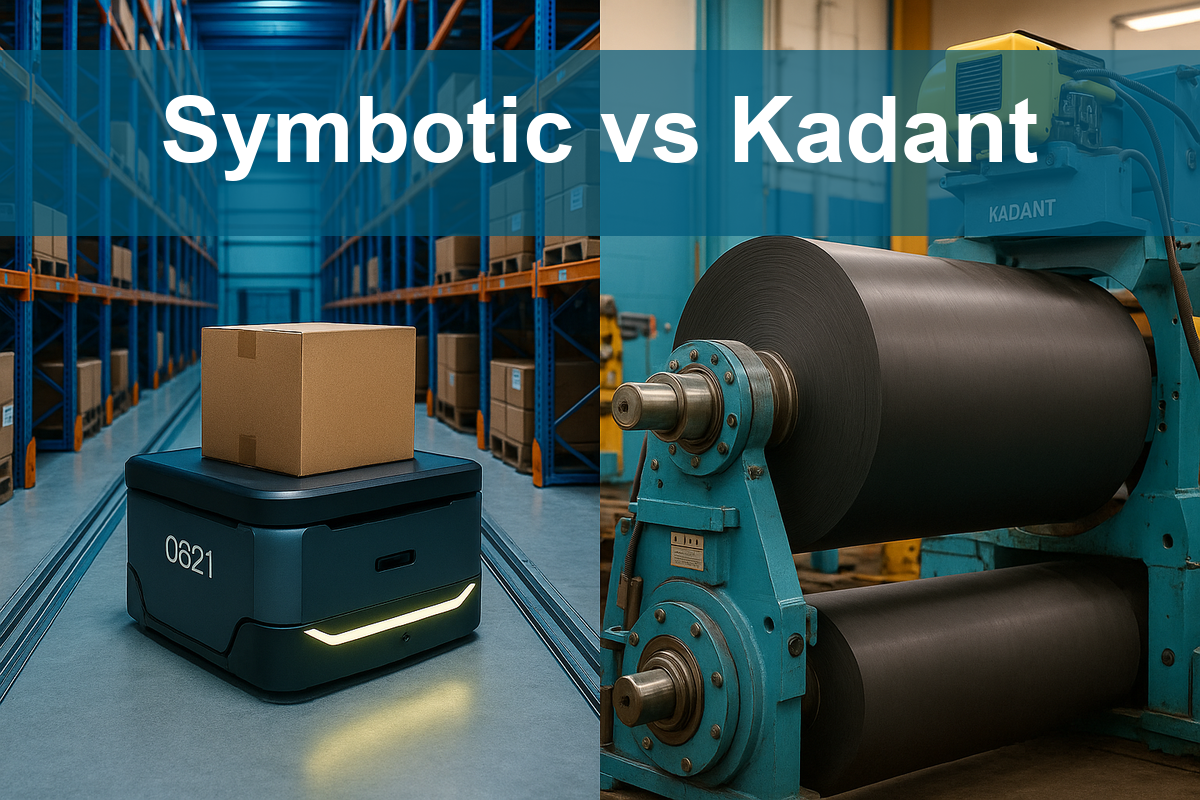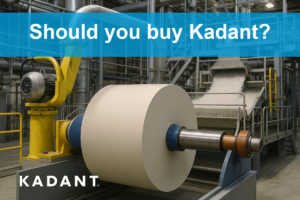In the ever-evolving industrial machinery sector, two companies stand out: Symbotic Inc. and Kadant Inc. Both firms are innovating to reshape how industries operate, yet they do so through distinct approaches. Symbotic focuses on advanced automation technologies for supply chain efficiency, while Kadant offers a diverse range of engineered systems for fluid handling and material processing. In this article, I will analyze these companies to help you determine which one might be the more compelling investment opportunity.

Table of contents
Company Overview
Symbotic Inc. Overview
Symbotic Inc. is an innovative automation technology company dedicated to enhancing operational efficiency for retailers and wholesalers across the United States. The firm offers The Symbotic System, a comprehensive warehouse automation solution designed to reduce costs, boost efficiency, and optimize inventory management. Headquartered in Wilmington, Massachusetts, Symbotic has positioned itself as a leader in the industrial machinery sector by integrating robotics with advanced technology. With a market capitalization of approximately $50.59B, the company is on a growth trajectory since its IPO in March 2021, reflecting the increasing demand for automated solutions in supply chain management.
Kadant Inc. Overview
Kadant Inc. operates as a global supplier of engineered systems and technologies, emphasizing fluid handling and industrial processing. With three distinct segments—Flow Control, Industrial Processing, and Material Handling—Kadant delivers a diverse range of products, including rotary joints, debarkers, and biodegradable absorbent granules. Founded in 1991 and headquartered in Westford, Massachusetts, the company has established a strong reputation in the industrial machinery sector, boasting a market cap of around $3.28B. Kadant’s commitment to innovation and sustainability positions it favorably within its competitive landscape.
Key similarities and differences
Both Symbotic and Kadant operate in the industrial machinery sector, focusing on enhancing efficiency through innovative technologies. However, they differ significantly in their core offerings; Symbotic specializes in warehouse automation, while Kadant provides a broader range of engineered systems across multiple segments, including fluid handling and material processing. This distinction influences their respective market strategies and customer bases.
Income Statement Comparison
The table below provides a comparison of key income statement metrics for Symbotic Inc. and Kadant Inc. for their most recent fiscal years.
| Metric | Symbotic Inc. | Kadant Inc. |
|---|---|---|
| Market Cap | 50.59B | 3.28B |
| Revenue | 2.25B | 1.05B |
| EBITDA | -75.40M | 222.69M |
| EBIT | -115.01M | 173.10M |
| Net Income | -80.57M | 111.60M |
| EPS | -0.16 | 9.51 |
| Fiscal Year | 2025 | 2024 |
Interpretation of Income Statement
In the most recent fiscal year, Symbotic Inc. reported a revenue increase to 2.25B, but still faced a substantial net loss of 80.57M, reflecting ongoing operational challenges. In contrast, Kadant Inc. showed strong performance with revenue growth to 1.05B and a net income of 111.60M, indicating robust profitability and effective cost management. While Symbotic’s EBITDA remains negative, Kadant’s positive EBITDA of 222.69M suggests strong operational efficiency. Thus, investors should carefully assess the contrasting financial health and performance trajectories of these companies.
Financial Ratios Comparison
The following table outlines a comparative analysis of key financial ratios for Symbotic Inc. (SYM) and Kadant Inc. (KAI) based on the latest available data.
| Metric | Symbotic Inc. (SYM) | Kadant Inc. (KAI) |
|---|---|---|
| ROE | -16.67% | 13.17% |
| ROIC | -17.47% | 10.08% |
| P/E | -70.32 | 36.90 |
| P/B | 11.73 | 4.86 |
| Current Ratio | 1.09 | 2.31 |
| Quick Ratio | 1.00 | 1.55 |
| D/E | 0.00 | 0.38 |
| Debt-to-Assets | 0.00 | 0.23 |
| Interest Coverage | 0.00 | 8.55 |
| Asset Turnover | 0.94 | 0.74 |
| Fixed Asset Turnover | 19.10 | 6.18 |
| Payout Ratio | 0.00 | 13.15% |
| Dividend Yield | 0.00% | 0.36% |
Interpretation of Financial Ratios
The financial ratios present contrasting pictures for SYM and KAI. SYM shows significant weaknesses, particularly with a negative ROE and ROIC, indicating poor profitability and capital efficiency. In contrast, KAI exhibits strong metrics, especially in ROE and current ratio, suggesting robust financial health and operational efficiency. While SYM’s high P/B ratio signals potential overvaluation, KAI’s lower ratios suggest a more attractive investment opportunity. Investors should exercise caution with SYM, while KAI appears to be a safer choice.
Dividend and Shareholder Returns
Symbotic Inc. (SYM) does not pay dividends, reflecting its negative net income and a focus on reinvesting in growth. Instead, it engages in share buyback programs, which can enhance shareholder value but also poses risks if financed unsustainably. In contrast, Kadant Inc. (KAI) offers a dividend yield of 0.36% with a payout ratio of 13.1%, supported by solid cash flow. This approach aligns with sustainable long-term value creation for shareholders.
Strategic Positioning
In the industrial machinery sector, Symbotic Inc. (SYM) holds a competitive edge with its innovative automation technologies aimed at enhancing warehouse efficiency. With a market cap of $51B, it demonstrates significant growth potential despite recent price fluctuations. On the other hand, Kadant Inc. (KAI), valued at $3.3B, offers a diversified range of engineered systems. Both companies face rising competitive pressure and technological disruptions, necessitating agile strategies to maintain their market positions.
Stock Comparison
In this analysis, I will review the weekly stock price movements and trading dynamics for Symbotic Inc. (SYM) and Kadant Inc. (KAI) over the past year, highlighting significant price changes and overall trends.

Trend Analysis
Symbotic Inc. (SYM) has demonstrated a substantial price change of +93.06% over the past year. This indicates a bullish trend, supported by an acceleration in price movement. The stock has experienced notable highs and lows, reaching a maximum price of 83.77 and a minimum of 17.5. Additionally, the standard deviation of 14.0 suggests moderate volatility in the stock’s price movements.
In the more recent analysis period from September 14, 2025, to November 30, 2025, SYM recorded a price change of +75.43%, with a standard deviation of 10.52. This period also reflects a positive trend slope of 1.71, further confirming the acceleration of the bullish trend.
Kadant Inc. (KAI), on the other hand, has seen a price change of +7.49% over the past year, indicating a bullish trend; however, the acceleration status is noted as deceleration. The stock’s highest price reached 419.01, with a low of 254.91, and a standard deviation of 35.59, indicating higher volatility compared to SYM.
In the recent analysis period from September 14, 2025, to November 30, 2025, KAI displayed a negative price change of -11.29%, with a standard deviation of 18.09 and a trend slope of -4.32, indicating a deceleration in price movement. This suggests that while KAI’s overall trend remains bullish, the recent performance raises concerns about potential short-term weakness.
In summary, SYM appears to be a strong candidate for investors seeking growth, while KAI, despite its overall bullish trend, may present short-term risks that warrant caution.
Analyst Opinions
Recent recommendations for Symbotic Inc. (SYM) reflect a cautious stance, with a rating of C from analysts. The primary concerns include weak return metrics and high debt levels. In contrast, Kadant Inc. (KAI) enjoys a more favorable outlook, receiving a B+ rating. Analysts highlight strong return on assets and equity as key strengths. As of now, the consensus leans towards a hold for SYM, while KAI is more favored, suggesting a buy. This differentiation underscores the importance of evaluating financial health before making investment decisions.
Stock Grades
I have analyzed the most recent stock grades for two companies, Symbotic Inc. (SYM) and Kadant Inc. (KAI). Here are the details:
Symbotic Inc. Grades
| Grading Company | Action | New Grade | Date |
|---|---|---|---|
| Barclays | maintain | Underweight | 2025-11-26 |
| Baird | maintain | Neutral | 2025-11-26 |
| Citigroup | maintain | Buy | 2025-11-25 |
| Northland Capital Markets | maintain | Outperform | 2025-11-25 |
| Cantor Fitzgerald | maintain | Overweight | 2025-11-25 |
| DA Davidson | maintain | Neutral | 2025-11-25 |
| Craig-Hallum | upgrade | Buy | 2025-11-25 |
| UBS | downgrade | Sell | 2025-09-23 |
| DA Davidson | downgrade | Neutral | 2025-08-25 |
| Needham | maintain | Buy | 2025-08-07 |
Kadant Inc. Grades
| Grading Company | Action | New Grade | Date |
|---|---|---|---|
| Barrington Research | maintain | Outperform | 2025-10-30 |
| Barrington Research | maintain | Outperform | 2025-10-29 |
| Barrington Research | maintain | Outperform | 2025-10-27 |
| Barrington Research | maintain | Outperform | 2025-10-10 |
| Barrington Research | maintain | Outperform | 2025-09-23 |
| DA Davidson | maintain | Neutral | 2025-08-04 |
| Barrington Research | maintain | Outperform | 2025-07-30 |
| Barrington Research | maintain | Outperform | 2025-07-29 |
| DA Davidson | maintain | Neutral | 2025-05-01 |
| Barrington Research | maintain | Outperform | 2025-05-01 |
In summary, Symbotic Inc. is seeing a mix of grades with some analysts maintaining a neutral to negative outlook, while Citigroup and Craig-Hallum show a more positive stance by maintaining “Buy” and upgrading the stock. On the other hand, Kadant Inc. enjoys a consistently strong “Outperform” rating from Barrington Research, indicating robust investor confidence in the company’s performance.
Target Prices
The target consensus for the stocks of Symbotic Inc. and Kadant Inc. indicates positive expectations from analysts.
| Company | Target High | Target Low | Consensus |
|---|---|---|---|
| Symbotic Inc. | 83 | 41 | 67.38 |
| Kadant Inc. | 410 | 275 | 342.5 |
For Symbotic Inc., the current stock price of 83.77 is slightly above the consensus target, suggesting a stable outlook. Meanwhile, Kadant Inc. is trading at 278.12, significantly below its consensus of 342.5, indicating potential upside.
Strengths and Weaknesses
The table below summarizes the strengths and weaknesses of Symbotic Inc. (SYM) and Kadant Inc. (KAI) based on recent data.
| Criterion | Symbotic Inc. (SYM) | Kadant Inc. (KAI) |
|---|---|---|
| Diversification | Limited product range | Diverse product segments across multiple industries |
| Profitability | Negative net profit margin (-3.59%) | Strong net profit margin (10.59%) |
| Innovation | Focus on automation technology | Established technologies and systems in various sectors |
| Global presence | Primarily U.S. based | Operates globally with a broader market footprint |
| Market Share | Emerging player in automation | Established player in industrial processing |
| Debt level | No debt | Moderate debt levels (0.38 debt/equity ratio) |
Key takeaways indicate that Kadant Inc. shows stronger profitability and diversification compared to Symbotic Inc., which is still developing its market presence and product range. Investors should consider these factors when evaluating their portfolios.
Risk Analysis
Below is a table summarizing the key risks associated with Symbotic Inc. (SYM) and Kadant Inc. (KAI).
| Metric | Symbotic Inc. | Kadant Inc. |
|---|---|---|
| Market Risk | High | Moderate |
| Regulatory Risk | Moderate | Low |
| Operational Risk | High | Moderate |
| Environmental Risk | Low | Moderate |
| Geopolitical Risk | Moderate | Low |
In my analysis, market and operational risks are significant for both companies. Symbotic faces high volatility due to its reliance on automation technology, while Kadant’s exposure is tempered by its diversified operations. Recent supply chain disruptions and regulatory changes add to these risks.
Which one to choose?
When comparing Symbotic Inc. (SYM) and Kadant Inc. (KAI), it’s evident that KAI exhibits stronger fundamentals. KAI boasts a gross profit margin of 44.25% and a net profit margin of 10.59%, while SYM’s margins are considerably lower, with a net profit margin of -3.59%. KAI also shows a better return on equity (ROE) of 13.17% compared to SYM’s negative ROE. The analysts have rated KAI as B+, indicating a more favorable outlook compared to SYM’s C rating.
For growth-focused investors, KAI appears to be a more stable choice due to its positive earnings and robust margins. However, SYM may appeal to investors willing to take on higher risk for potential long-term gains as it has recently shown a significant price increase of 93.06%.
It’s essential to note the competitive landscape and market dependence, which may pose risks for either company.
Disclaimer: This article is not financial advice. Each investor is responsible for their own investment decisions.
Go further
I encourage you to read the complete analyses of Symbotic Inc. and Kadant Inc. to enhance your investment decisions:



